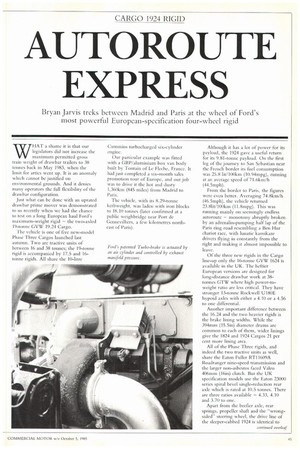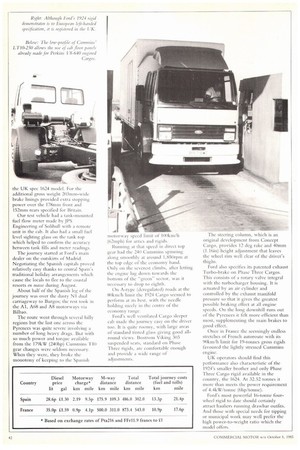AUTOROUTE EXPRESS
Page 43

Page 44

If you've noticed an error in this article please click here to report it so we can fix it.
Bryan Jarvis treks between Madrid and Paris at the wheel of Ford's most powerful European-specification four-wheel rigid
WHAT a shame it is that our legislators did not increase the maximum permitted gross train weight of drawbar trailers to 38 tonnes back in May 1983, when the limit for artics went up. It is an anomaly which cannot be justified on environmental grounds.. And it denies many operators the full flexibility of the drawbar configuration.
Just what can be done with an uprated drawbar prime mover was demonstrated to us recently when we had the chance to test on a long European haul Ford's maximum-weight rigid — the two-axled 19-tonne GVW 19.24 Cargo.
The vehicle is one of five new-model Phase Three Cargos launched last autumn. Two are tractive units of between 16 and 38 tonnes; the 19-tonne rigid is accompanied by 17.5 and 16tonne rigids. All share the 10-litre Cummins turbocharged six-cylinder engine.
Our particular example was fitted with a GRP/aluminium box van body built by Tontain of Le Fleche, France. It had just completed a six-month sales promotion tour of Europe, and our job was to drive it the hot and dusty 1,360km (845 miles) from Madrid to Paris.
The vehicle, with its 8.29-tonne kerbweight, was laden with iron blocks to 18.10 tonnes (later confirmed at a public weighbridge near Port de Gennevilliers, a few kilometres northeast of Paris).
Although it has a lot of power for its payload, the 1924 gave a useful return for its 9.81-tonne payload. On the first leg of the journey to San Sebastian near the French border its fuel consumption was 25.8 lit/100kni (10.94mpg), running at an average speed of 71.6km/h (44.5mph).
From the border to Paris, the figures were even better. Averaging 74.8km/h (46.5mph), the vehicle returned 23.81it/100kin (11.8mpg). This was running mainly on seemingly endless autoroute — monotony abruptly broken by an adrenalin-pumping half lap of the Paris ring road resembling a Ben Hur chariot race, with lunatic kamikaze drivers flying in constantly from the right and making it almost impossible to leave.
Of the three new rigids in the Cargo line-up only the 16-tonne GVW 1624 is available in the UK. The heftier European versions are designed for long-distance drawbar work at 38tonnes GTW where high power-toweight ratio are less critical. They have stronger 13-tonne Rockwell U180E hypoid axles with either a 4.10 or a 4.56 to one differential.
Another important difference between the 16.24 and the two heavier rigids is the brake lining widths. While the 394mm (15.5in) diameter drums are common to each of them, wider linings give the 1824 and 1924 Cargos 21 per cent more lining area.
All of the Phase Three rigids, and indeed the two tractive units as well, share the Eaton Fuller RT11609A Roadranger nine-speed transmission and the larger non-asbestos faced Valeo 406non (16in) clutch. But the UK specification models use the Eaton 23000 series spiral bevel single-reduction rear axle which is rated at 10.5 tonnes. There are three ratios available — 4.33, 4.10 and 3.70 to one.
Apart from the beefier axle, rear springs, propeller shaft and the "wrongsided" steering wheel, the drive line of the sleeper-cabbed 1924 is identical to
the UK spec 1624 model. For the additional gross weight 203mm-wide brake linings provided extra stopping power over the 178mm front and 152mm rears specified for Britain.
Our test vehicle had a tank-mounted fuel flow meter made by JPS Engineering of Solihull with a remote unit in the cab. It also had a small fuel level sighting glass on the tank top which helped to confirm the accuracy between tank fills and meter readings.
The journey started at Ford's main dealer on the outskirts of Madrid. Negotiating the Spanish capitals proved relatively easy thanks to central Spain's traditional holiday arrangements which cause the locals to flee to the coastal resorts en masse during August.
About half of the Spanish leg of the journey was over the dusty NI dual carriageway to Burgos; the rest took in the Al, A68 and AS motorways via Bilbao.
The route went through several hilly regions but the last one across the Pyrenees was quite severe involving a number of long heavy drags. But with so much power and torque available from the 179kW (240hp) Cummins T10 gear changes were seldom necessary. When they were, they broke the monotony of keeping to the Spanish motorway speed limit of 1110km/h (62mph) for artics and rigids.
Running at that speed in direct top gear had the 240 Cummins spinning along smoothly at around 1,850rpm at the top edge of the economy band. Only on the severest climbs, after letting the engine lug down towards the bottom of the "greensector, was it necessary to drop to eighth.
On A-type (deregulated) roads at the SC 1k limit the 1924 Cargo scented to perform at its best, with the needle holding nicely in the centre of the economy range.
Ford's well ventilated Cargo sleeper cab made the journey easy on the driver too. It is quite roomy, with large areas of standard tinted glass giving good allround views. Bostrom Viking 303 suspended seats, standard on Phase Three rigids, arc comfortable enough and provide a wide range of adjustments. The steering column, which is an original development from Concept Cargo, provides 12 deg rake and 40min (1.16in) height adjustment that leaves the wheel rim well clear of the driver's thighs.
Ford also specifies its patented exhaust Turbo-brake on Phase Three Cargos. This consists of a rotary valve integral with the turbocharger housing. It is actuated by an air cylinder and controlled by the exhaust manifold pressure so that it gives the greatest possible braking effect at all engine speeds. On the long downhill runs out of the Pyrenees it felt more efficient than most, supplementing the main brakes to good effect.
Once in France the seemingly endless stretches of French autoroute with its 90km/h limit for 19-tonnes gross rigids favoured the lightly stressed Cummins engine.
UK operators should find this performance also characteristic of the 1924's smaller brother and only Phase Three Cargo rigid available in the country, the 1624. At 32.52 tonnes it more than meets the power requirement of 4.4k Witonne (6hp/tonne).
Ford's most powerful 16-tonne fourwheel rigid to date should certainly attract hauliers running drawbar outfits. And those with special needs for tipping or municipal work may well prefer the high power-to-weight ratio which the model offers.












































































































